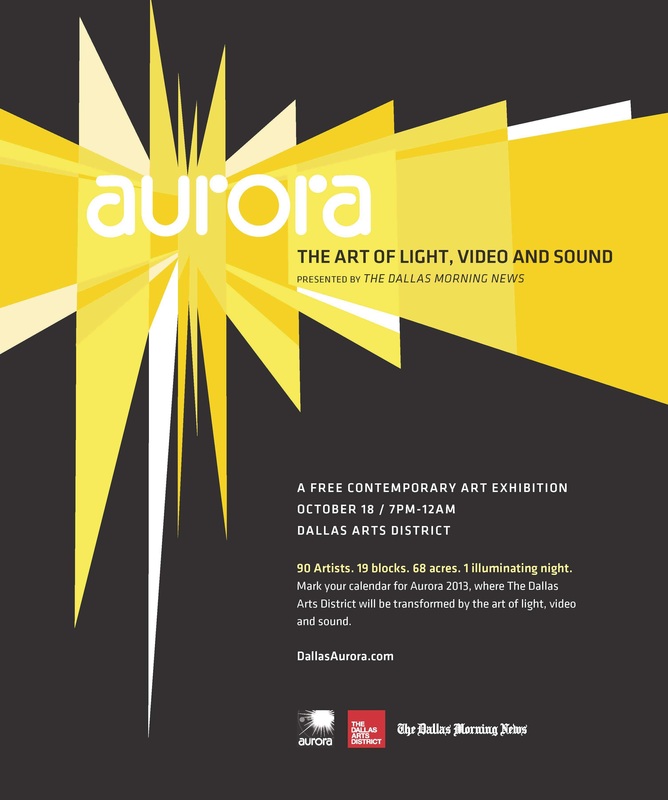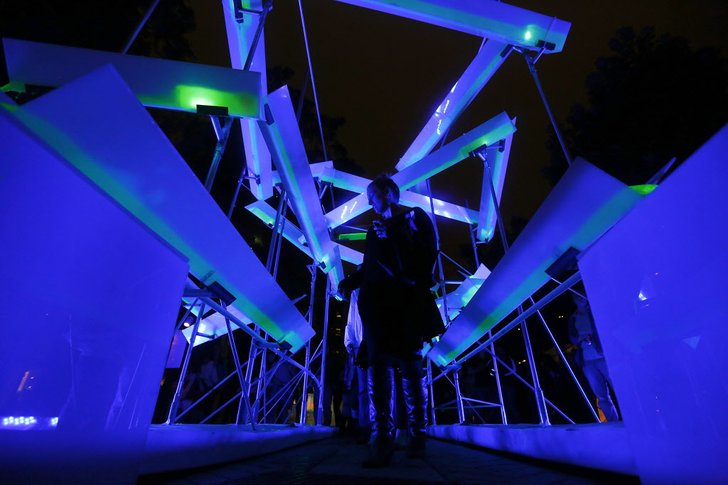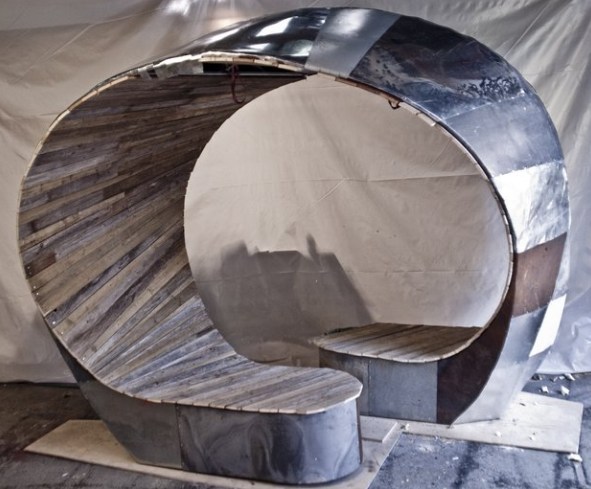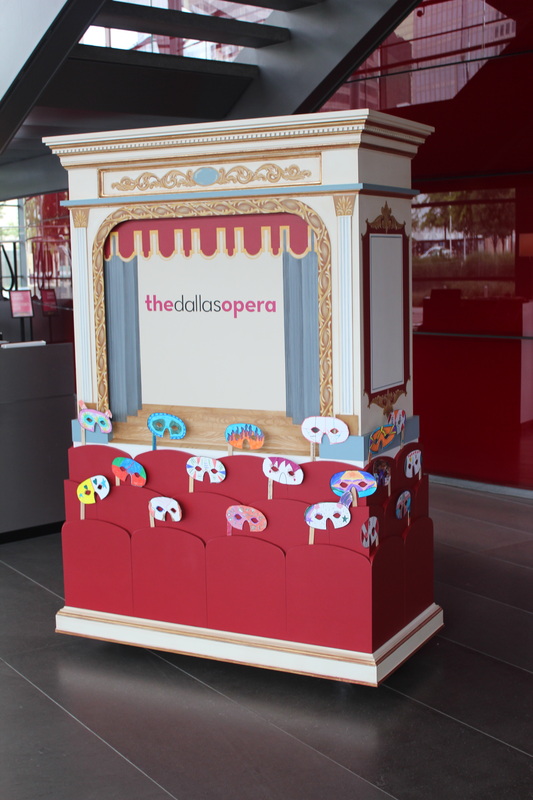AURORA 2013
"Data Flow" by Nicole Cullum Horn, Erik Glissmann and Scott Horn
“Data Flow” reflects on the expansion of human consciousness in the digital era. For most of our history, our experiences have been limited to our immediate horizons, securing our sense of the world and our place in it. Digital technology has transformed that stability, shattering and expanding it a thousandfold – like a river divided by a thousand tiny waterfalls. Data Flow physically interprets this phenomenon; a single stream falls onto many planes, reaching its destination by a seemingly random multitude of paths.
Spare Parts: Mobius Bench
The Mobius Bench is a dynamic structure designed to provide built-in seating and shade for pedestrians along the Ft. Worth Avenue corridor. This bench is a seemingly simple round shape yet in its curvature becomes intriguingly complex. Following the infinite curve of the Mobius strip, the structure surrounds and arches over it’s patrons to emcompass and provide shade against the Texas summer sun. As the arch returns to the ground it will end in two round benches that are situated diagonally across from each other. The benches are designed to face each other to encourage a street-level conversation about art in an everyday setting.
Part of the Dallas Observer series on busking, episode 8 features the Whiskey Folk busking at the Mobius Bench on Fort Worth Avenue.
The Dallas Opera
The Dallas Opera commissioned myself and the help of Erik Glissmann of Measured Improvements to design and fabricate a kiosk to display hand made masks, letters, and information about the Dallas Opera's after school programming. The kiosk currently resides at the AT&T Performing Arts Center in the heart of the Dallas Arts District.
Parade of Giants
La Reunion TX & The Margaret Hunt Hill Bridge Opening Ceremony
The Parade of Giants partnered Dallas artists with local community groups to create large scale puppets in the likeness of 15 different individuals who during their lives had a significant impact on the history of West Dallas. The program was hosted by La Reunion TX as one of the Bridge-o-Rama's eight Signature Events celebrating the opening of the Margaret Hunt Hill Bridge on March 3rd, 2012. Each puppet along with the artists and community groups were marched across the new bridge to tell a visual story of the history of the area.
My puppet was Victor Considerant, the founder of the orignal La Reunion colony which was established in 1855 on the outskirts of Dallas Tx. Considérant was one of the leading democratic socialist figures in France during the volatile revolutionary period of 1830 to 1850. Early in 1855 agents sent by Considérant bought about 2,500 acres of land on the banks of the Trinity River near Dallas. Before adequate provision had been made for them, however, nearly 200 colonists made their way to La Réunion. Considerant hosted craftsmen, artists, writers and the area's first brew master but neglected to attend to farming and endured an especially harsh winter that left the colony starved and in financial ruin. The colony dispersed 18 months later with colonists either returning to France or moving into Dallas proper.
Special thanks to Erik Glissmann for creating the structure for Victor and many hours of creative problem solving. With out his help, Victor would never have stood up on his own or made it across the bridge. Thank you.
My puppet was Victor Considerant, the founder of the orignal La Reunion colony which was established in 1855 on the outskirts of Dallas Tx. Considérant was one of the leading democratic socialist figures in France during the volatile revolutionary period of 1830 to 1850. Early in 1855 agents sent by Considérant bought about 2,500 acres of land on the banks of the Trinity River near Dallas. Before adequate provision had been made for them, however, nearly 200 colonists made their way to La Réunion. Considerant hosted craftsmen, artists, writers and the area's first brew master but neglected to attend to farming and endured an especially harsh winter that left the colony starved and in financial ruin. The colony dispersed 18 months later with colonists either returning to France or moving into Dallas proper.
Special thanks to Erik Glissmann for creating the structure for Victor and many hours of creative problem solving. With out his help, Victor would never have stood up on his own or made it across the bridge. Thank you.
Sue's Horse
As a last gift, a client's father bought the favorite carousel horse she used to ride from her tiny west Texas hometown. Unfortunately, in the dismantling process, the horse was stripped back to it's aluminum body. Sue wanted to restore her beloved horse but give it a more authentic look by replicating the very first carousel horses that were originally made out of wood. I created a faux bois undercoat and layered the body and saddle with peeling aged paints and gilded trim.
Aurora 2011
The Evolvoscope
Nicole Cullum Horn, Erik Glissmann, Scott Horn
On October 28th, 2011, the Dallas Arts District was aglow with light installations from over one hundred light, video and sound artists at Dallas Aurora. The Evolvoscope is a large scale re-imagining of a praxinoscope and a zoetrope. As you spin the lighted structure you can watch the evolution from monkey to man to robot and back again. Click here to see an animated gif of the Evolvoscope.
Make Space- La Reunion TX
Waste Not, Want Not
On-site installation at La Reunion TX
Waste Not, Want Not is a charged symbol of our struggle with water waste, personal usage, and conservation efforts in our community and nationally. A floating, oversized replica of a white bathtub drain tethered to the ponds edge with a chain made from La Reunions’ natural materials, and found trash. I would like to turn a conscientious eye towards the individuals’ daily water consumption. Simple self-monitoring, like how you wash your dishes or shower, can make a significant impact on stabilizing our water levels and controlling our daily usage. My hope is to jumpstart a community-based conversation on little ways each person and family can use less water daily, and still maintain quality of life standards.
Many Thanks to my Sponsors:
Dan and Karen Cullum
Dallas Plastic Rescue
The Shelton School
Mimi Drew
Cari Weinberg
David Hickmott
Waste Not, Want Not is a charged symbol of our struggle with water waste, personal usage, and conservation efforts in our community and nationally. A floating, oversized replica of a white bathtub drain tethered to the ponds edge with a chain made from La Reunions’ natural materials, and found trash. I would like to turn a conscientious eye towards the individuals’ daily water consumption. Simple self-monitoring, like how you wash your dishes or shower, can make a significant impact on stabilizing our water levels and controlling our daily usage. My hope is to jumpstart a community-based conversation on little ways each person and family can use less water daily, and still maintain quality of life standards.
Many Thanks to my Sponsors:
Dan and Karen Cullum
Dallas Plastic Rescue
The Shelton School
Mimi Drew
Cari Weinberg
David Hickmott
Art Chicas Unidas
Metamorphosis
In coordination with La ReUnion TX Art Chicas Unidas, and the Girl Scouts of NorthEast Texas, Pegasus Charter School, Buckner and Deaf Action Center of Texas I, along with three other artists, participated in a mentor-apprentice workshop to create large on-site installation art. Our project was to create a series of large cocoons that will represent the evolution of change and the passage of time. We studied different forms of how nature conducts transformation by researching the processes of insect metamorphosis. We then began to create the cocoons' structures by wrapping a series of balloons with over 27,000 feet of glue covered, sisal twine. After drying, I opened the cocoons to create miniature scenes that express different metaphors of time passing. Now that some time has passed, the cocoons have begun to decompose due to weather and humidity. I enjoy these new forms as much as the original pieces, and welcome the acquired beauty that only time's passing can give.
Function Installation Show
High 5
Nicole and Scott Horn
November 22, 2008 Dallas, TX
High Five is a roughly 30'x30'x7' reinterpretation of the massive freeway interchange located at Interstate 635 and Highway 75. The interchange is recreated from heavy cotton duck canvas and suspended from the ceiling with bailing wire. The undersides of the roadways are bright patterns, playfully mimicking the color coding that TXDOT used in the actual interchange. By releasing the structure from its tether to the ground, the rigid nature of the system transforms into a free-floating series of arcs, ramps, and curves to reveal the beauty of the design.
With this installation we hope to spark an awareness of the conflict inherent in human ‘progress’ and raise questions about continuing an unsustainable model of societal development. The DFW metroplex has the 4th largest population in the United States and is bigger than Rhode Island and Connecticut combined. The High Five project cost the city of Dallas $261 million dollars and was started in 2002 and completed in December 2005. The interchange comprises 37 bridges distributed across 5 levels. The highest ramp is 120 feet in the air which accompanies nearly 60 lane-miles of new roadway and stretches 2.4 miles north/south and 3.4 miles east/west. The High Five interchange presents a daring architectural work, touted by the city of Dallas to be a relief to the endless traffic. Each day people gamble their lives to travel through this dense and often dangerous road system.
The roadway authorities have designed the city of Dallas to be an ever expanding layout where land is cheap and house lots are large. This city sprawl effect dramatically increases the traffic load on our roadways and the amount of time it takes to travel across the metroplex. Due to the enormous population and inadequate public transportation, residents are almost forced to own a vehicle. The pedestrian challenged road design separates the community into two classes; those who can afford a vehicle and those who are forced to figure out our lackluster public transportation system.
November 22, 2008 Dallas, TX
High Five is a roughly 30'x30'x7' reinterpretation of the massive freeway interchange located at Interstate 635 and Highway 75. The interchange is recreated from heavy cotton duck canvas and suspended from the ceiling with bailing wire. The undersides of the roadways are bright patterns, playfully mimicking the color coding that TXDOT used in the actual interchange. By releasing the structure from its tether to the ground, the rigid nature of the system transforms into a free-floating series of arcs, ramps, and curves to reveal the beauty of the design.
With this installation we hope to spark an awareness of the conflict inherent in human ‘progress’ and raise questions about continuing an unsustainable model of societal development. The DFW metroplex has the 4th largest population in the United States and is bigger than Rhode Island and Connecticut combined. The High Five project cost the city of Dallas $261 million dollars and was started in 2002 and completed in December 2005. The interchange comprises 37 bridges distributed across 5 levels. The highest ramp is 120 feet in the air which accompanies nearly 60 lane-miles of new roadway and stretches 2.4 miles north/south and 3.4 miles east/west. The High Five interchange presents a daring architectural work, touted by the city of Dallas to be a relief to the endless traffic. Each day people gamble their lives to travel through this dense and often dangerous road system.
The roadway authorities have designed the city of Dallas to be an ever expanding layout where land is cheap and house lots are large. This city sprawl effect dramatically increases the traffic load on our roadways and the amount of time it takes to travel across the metroplex. Due to the enormous population and inadequate public transportation, residents are almost forced to own a vehicle. The pedestrian challenged road design separates the community into two classes; those who can afford a vehicle and those who are forced to figure out our lackluster public transportation system.



